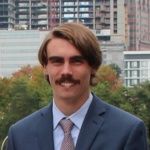
The live recording of this presentation is available on the CAPE-OPEN Channel at YouTube.
Dylan obtained his B.Sc from Clemson University in May 2018 and he is a PhD student under the supervision of Prof. SCOTT since November 2018. A paper on the work presented here, titled “Framework for Predicting the Fractionation of Complex Liquid Feeds via Polymer Membranes” by Ronita Mathias, Dylan Weber, Kirstie Thompson, Bennett Marshall, M. G. Finn, Joseph Scott, Ryan Lively, was recently accepted for publication in Journal of Membrane Science.
Summary
In recent years, the chemical industry has shown increasing interest in intensifying processes through the use smaller unit operations with lower capital costs, lower carbon footprints, and higher energy efficiency. Since most industrial energy is dedicated to chemical separations, membrane processes are a promising route towards this process intensification goal. Despite the vast literature on industrial membrane separations, only dilute carbon capture and reverse osmosis have seen widespread industrial adoption. Industrial membrane processes involving complex solvent mixtures have yet to see many commercial installations even though many important applications have been identified. Complex solvent mixtures have no single majority component and usually give rise to mixture interactions (thermodynamic or diffusional coupling) between species. One of the reasons for such limited industrial adoption is the lack of efficient and reliable simulation methods that are compatible with standard process flowsheeting software. This is key to enabling technoeconomic comparison of membrane and non-membrane processes on a consistent basis.
For over two decades, CAPE-OPEN standards have transformed the interoperability of community generated process modeling components (PMCs) with process modeling environments (PMEs). These user generated PMCs allow for complex unit operations that many commercial PMEs are unable to develop based on knowledge gaps in the modeling and simulation methods. In this work, we will present the use of CAPE-OPEN standards to implement a novel simulation method for complex solvent mixture transport through polymer membranes within a commercial PME. Specifically, we will describe the use of AmsterCHEM’s MATLAB CAPE-OPEN unit operation to link a custom membrane simulation code in MATLAB with a sophisticated thermodynamics model in the PME for predicting bulk feed and permeate activity coefficients. Then, we will show through several case studies that combining these capabilities leads to better prediction of experimental data compared to ideal solution assumptions. We will also discuss the strengths and weaknesses of this software and our experience understanding and implementing it. In summary, this work takes a step forward towards the prediction of complex hydrocarbon mixture membrane separations within standard process flowsheeting software.
